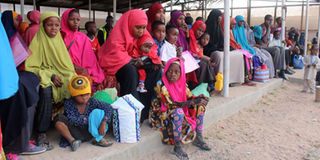Slow repatriation drags back Dadaab shutdown plans

Somali refugees from Dadaab refugee camp in Turkana County wait to board a flight to Kismayu, Somalia, on December 19, 2017. Currently, the repatriation had slowed down due to the weather. PHOTO | ROBERT GICHIRA
What you need to know:
- In all, Kenya currently hosts about 285,705 Somali refugees with a few of them in Kakuma in Turkana.
- The government had in 2014 announced its intention to close the 26-year-old refugee camp due to alleged security threats.
More than 34,000 Somali refugees have voluntarily returned to their country this year, bringing the total number of those who have gone back since 2014 to nearly 75,000.
The figure is way below Kenya’s 2014 targets to repatriate and shut Dadaab - the world’s largest refugee camp - which currently hosts a total of 238,617 refugees, a majority of them Somalis.
In all, Kenya currently hosts about 285,705 Somali refugees with a few of them in Kakuma in Turkana, and the others in the capital Nairobi.
There were a total of 34,983 repatriations of Somali refugees in 2017 as at last week.
SECURITY THREATS
The United Nations High Commissioner for Refugees (UNHCR) said that the process was “completely voluntary” but warned that it might take longer to conclude.
“We are satisfied with the process, that it is voluntary. Those that leave make the decision to leave, nobody is imposing on them to leave,” Mr Filippo Grandi, the UNHCR head, told journalists at a press conference in Nairobi on Thursday.
The Kenyan government had in 2014 announced its intention to close the 26-year-old refugee camp due to alleged security threats.
In all, Kenya hosts a total of 489,071 refugees as at November 30, 2017.
TRANSPORT
Of the 74,873 that have returned to Somalia since 2014; 48,624 landed in Kismayu, 13,281 in the capital Mogadishu, with the others in Baidoa, Luuq, Afmadow and Afgoye provinces.
Currently, the UN agency said, the repatriation had slowed down due to the weather.
“We are only taking them back now using air because of the weather, and when it gets back to normal, we will re-introduce convoys,” Mr Grandi said.
Earlier, Mr Grandi had held a meeting with President Uhuru Kenyatta at his Harambee House office where the Head of State said the interests of local communities in areas hosting refugee camps should not be overlooked as the global refugee body caters for the needs of the refugees.
“As we carry out the voluntary repatriation of Somali refugees, we must not ignore the interests of the local communities,” President Kenyatta said in the meeting.
RELIEF AID
Mr Grandi was accompanied in the Harambee House meeting by Mr Ahmed Hussen, the Canadian immigration, refugees and citizenship minister.
Mr Hussen also said Canada will announce an additional Sh618 million ($ 6 million) grant to help people affected by drought to normalise life, particularly in areas hosting refugees.
This will add to the $4 million that Canada contributes to the World Food Programme to help 500,000 refugees in Kenya, as well as three million Kenyans.
Canada is also donating $5 million to help the UNHCR in Kenya.
SOUTH SUDAN
And while the repatriation process was ongoing, Mr Grandi said, it was difficult to say what effect it will have on Dadaab.
“It is very difficult for me to talk about the future of Dadaab now,” he said, arguing that only if the process of repatriation evolved quickly will the camp be closed.
Of the 22,319 refugees that have arrived in Kakuma since January, the UN agency data show that 16,020 of them, or 72 per cent, were from the neighbouring South Sudan ravaged by civil war pitting the two dominant communities loyal to President Salva Kiir on one hand and his former deputy Riek Machar on the other.
And with the influx of the refugees, Mr Grandi said the international community should continuously fund refugee programmes.
The UN agency warned against what it said was an unfair downgrade of funding for the refugee programmes.





